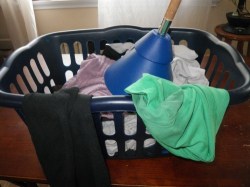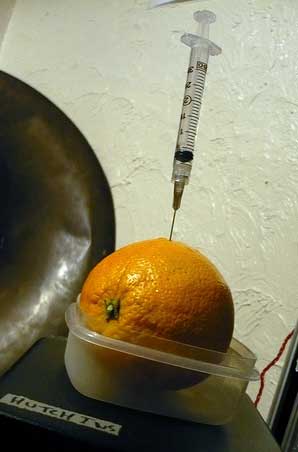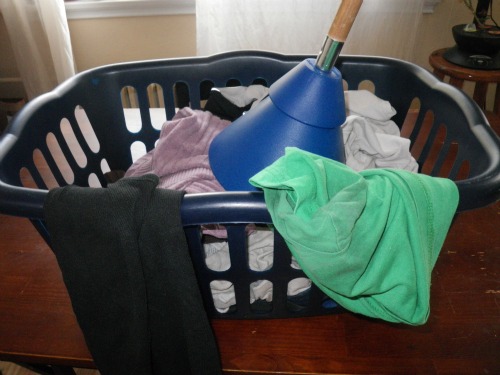
Toilet plunger? Or magical efficient clothes washer? (Photo by Elisabeth Kwak-Hefferan.)
If you ranked a list of household chores in order of how much dread they inspire in me, laundry falls somewhere between “feeding the cat” and “eating the leftover cupcakes before they get stale.” In other words, not so bad. Perhaps it’s because conventional clothes-cleaning is so automated these days. You don’t have to do or even think much about it, especially if your building or (oh, the luxury!) home has a washer and dryer: Load it, soap it, come back and tumble-dry it.
Convenient as it is, though, all that laundry demands an ecological tariff payable in loads of water and electricity. Once you put a little thought into reducing the impact of your hamper, getting your tighty-whities sparkling clean isn’t quite so simple anymore. In fact, if your solution is a handheld washing stick, it can be downright exhausting.
I didn’t know products like the Breathing Mobile Washer existed before my mom showed me an ad last week. “This glorified toilet plunger thinks it can improve on my laundry habits, huh?” I thought at first. But when I heard the washer’s claims to de-stankify my clothes without using any electricity and very little water — while providing a solid arm workout to boot — I knew I had to try it.
The idea is that you fill a tub, sink, or bucket with a few inches of water, add a bit of soap, and work over the laundry with an enthusiastic pumping motion. This creates suction that alternately pushes and pulls water through the fabric, allegedly creating superior sudsing action. Rinse with more pumping, wring the clothes out, and hang them on your clothesline (or, as the instructions call it, the “solar clothes dryer”).
I admit: I was skeptical. Even if this tool does successfully freshen up my clothes, I wondered, how long would it take to butter-churn a load of dirty laundry into submission? Images of generations of women beating soiled clothing against stones down by the river flashed before my eyes, and I cringed. Haven’t the wonders of technology moved Americans past this sort of toil by now?
Then again, the washing machine ranks second among home-appliance water hogs (behind the ever-greedy toilet, a topic that, incidentally, I’ve also got something to say about). High-efficiency (HE) models average about 14 gallons per load, and regular washers guzzle 27 gallons or more.
And both the washer and dryer, whether they’re HE models or not, suck up varying amounts of electricity. If this mobile washer can improve on that, it’s got to be worth a shot, right? (It’s not even the simplest option out there, should you decide to go this route.)
I cajoled my boyfriend, Ted, and his visiting brother, Jeff, into donating some dirty laundry to the cause. “There’s no … risk involved, is there?” Jeff said, eyeing the washing stick warily before surrendering his pants. I assured him of the safety of his threads, then added them to my pile of jeans, sweaty gym shirts and socks, quick-dry hiking pants, underwear, and T-shirts. Into the tub they went.
I filled the bathtub with about five inches of water per the plunger’s instructions, measured out the recommended half-teaspoon of detergent, decided that couldn’t be right and added another dollop, then went to work.
With an asthmatic wheeze, the washing stick sprung to life. I plunged it repeatedly over the clothes, occasionally stirring them around and stopping to reattach the pole, which came unscrewed from its base twice. The directions cheerily noted that “normally, a couple of minutes will be sufficient to wash your clothes,” but it took me about seven or eight until the water had become dingy enough to satisfy.
I drained the tub, then refilled it with fresh water for rinsing and went back into the plunge routine. All looked good — no suds left, and the clothes appeared clean. But despite the ache in my back from bending over the tub so intently, the hard part was yet to come: wringing the clothes dry. Without a mechanical clothes-wringer or even a salad spin-dry bowl to help, I had to squeeze the duds as dry as possible with my hands. I could hardly make a fist by the time I was done.
The good news? The washing stick basically cleaned our laundry. The suspense was acute, though: My hand-wringing meant the clothes didn’t fully air-dry for more than 24 hours. Seriously. Obviously nothing had that fresh-from-the-dryer fluffiness, but most were fine. A few items definitely failed the sniff test and went right back into the hamper, though. Guess I should have used even more soap.
The bad news? This one small load — maybe half the size of what our building’s HE washing machine swallows — easily took me 40 minutes of concentrated labor to finish. I imagined trying to keep up with my household’s weekly laundry load with this method alone and immediately felt panicked. How could I get any work done? Why, I’d have to plunge a tubful of clothes every night to keep up! I pictured myself wash-weary and bitter, stooped over the tub for hours every week, no time for hiking or reading or social interaction. “Hey!” I’d holler from the bathroom every so often. “Needs more soap!”
I can see using the plunger method once in a while, to reduce the number of regular washing-machine loads and to handle delicates. I’d use it to carefully wash my dry-clean-only items, which I never take to the dry cleaner anyway. But every load? Maybe I just need some practice. Maybe a wringer would speed up the drying process. Maybe just two minutes of plunging really would be sufficient. I’ll allow for these possibilities.
Would you ever try the plunge method for your laundry? If you already do, have you learned any tricks? Because right now, dashing clothes against the rocks down by the river sounds like a better deal.




